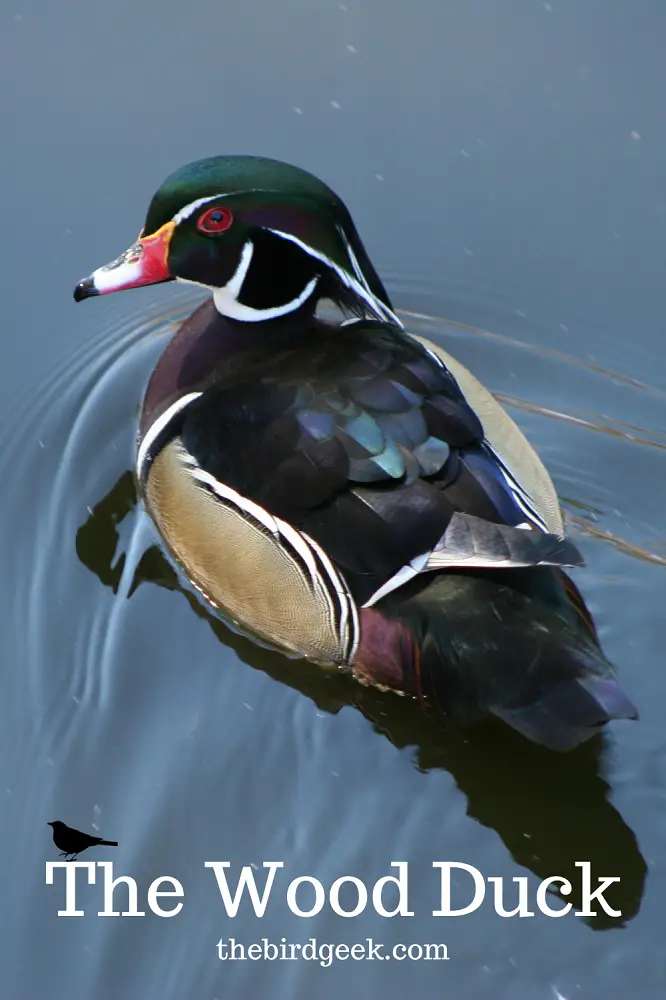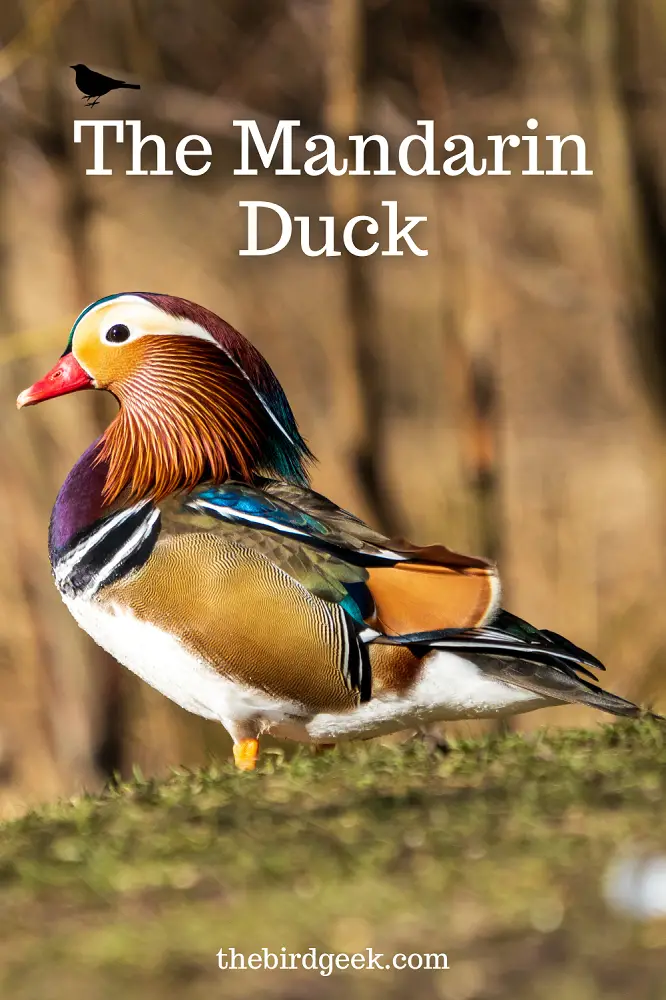Wood Duck vs Mandarin Duck
As a birder, you know that some species get so easily confused that some people think they’re the same. For instance, it’s very hard to find anyone (even among bird lovers like us) that knows the differences between wood ducks and mandarin ducks. Simply put, too many people think that they’re the same species! Well, we’re here to help break through that misunderstanding by providing detailed information about both species that can help you tell them apart.
What’s the Difference Between a Wood Duck and a Mandarin Duck?

- Location: Mandarin Ducks, East Asia; Wood Ducks, North America and Europe.
- Nesting: Mandarin Ducks: Ground; Wood Ducks: Tree Cavities.
- Male Appearance: Mandarin Ducks: Orange and Blue Markings With Greenish-Blue Stripes; Wood Ducks: Bright Red Eyes With Multi-Colored Eyes.
- Female Appearance: Mandarin Ducks: Subdued But Colorful; Wood Ducks: Brown or Gray.
Details About the Wood Duck

Let’s take an in-depth look at important facts that define the wood duck as a species. This popular duck was once near extinction but has become more widespread in recent years, expanding throughout the north and west of the North American continent. On that note, let’s jump right into their spread to get an idea of where they’re most likely to be found.
Range
The wood duck is commonly found throughout the North American continent, particularly through the eastern portion just past the Mississippi River region. For example, it’s commonly found all season in warm areas, including areas south of the Mason-Dixon Line. However, they’re also commonly found all-season along the Pacific Ocean coast, including in California and up into the warmer parts of southern Canada, depending on the year.
That said, they also breed throughout many parts of the northeast, including up to Maine, Michigan, and even Minnesota. They will spend most of the warm season in these areas before migrating down to warmer areas, where they feel more comfortable. This different location makes them easier to tell apart from Mandarin ducks: the latter duck is simply not in North America and is quite different from the wood duck for this reason.
Feeding Behavior and Diets
Wood ducks typically prefer feeding in water by taking food right off the surface or partially submerging their head and neck. Sometimes, you might even spot them up-ended in the water, with their tail feathers waving in the wind! This cute behavior is common among ducks and gives you a chance to spot their often colorful and engaging tail feathers more easily.
As for food, the wood duck prefers seeds, aquatic plants, insects, and crustaceans. However, they prefer eating acorns whenever possible and will spend a good part of each day snatching up these delicious (to them!) beauties. Note that the young ducks will prefer eating insects because they need a higher level of protein to grow: they mature out of this habit by their first year or so.
Breeding Behaviors
The wood duck female typically lays between 9-14 eggs per brood, though it may lay as few as six depending on the individual. The female is the sole incubator and sits on the eggs for 25-35 days, while the male brings food for her. After about 5-6 weeks of tending and a total of 8-9 weeks, the ducklings are ready to fly. Wood ducks have no more than 1-2 broods per year, depending on location.
Migration Patterns
Wood ducks in northern climates typically migrate south for the winter, often flying thousands of miles to settle down for the season. However, southern ducks will stay in the same area all year round, creating large colonies of wood ducks that may settle on lakes, rivers, or ponds. They’re a relatively mild-mannered bird, meaning they’re not too aggressive towards other species. That makes them an enjoyable bird to have hanging around your yard!
Related post: Bluebirds vs Purple Martins
Details About the Mandarin Duck

The Mandarin duck is one of the most colorful and beautiful bird species on the planet and is typically highly sought after in its natural habitat. Often, they’re called wood ducks, which has led to considerable confusion between the two species. While they look similar and have some similarities, they’re different birds! Here’s what you need to know about the Mandarin duck.
Range
The Mandarin duck is aptly named: they range throughout most of the Asian region, including China, North Korea, South Korea, and Japan. They’re even found in some parts of Russia, particularly in the southeast region. They have even pushed a little towards eastern parts of Europe, though they have also migrated as far west as Berlin, Germany, though their numbers here remain relatively small due to harsher winters in this city.
Furthermore, the Mandarin duck has escaped from more than one zoo around the world, which has caused them to spread to other parts of the planet. While these non-native populations are relatively small in concentration, the Mandarin duck is an adaptable bird that can feel comfortable in many environments. There are even small numbers in North America due to escapes, though their exact location and number are hard to estimate: most are in the western US.
Feeding Behavior and Diets
The Mandarin duck is an omnivorous creature, similar to the wood duck. However, they’re more diverse in their eating habits than their relatively picky cousins. They like to eat a diverse array of plants and small creatures, including weeds, invertebrates, seeds, and small fish. Mandarin ducks also love grains, rice, and other types of plants and typically focus as much as possible on these growths whenever possible.
That said, they also feed on snails, insects, worms, frogs, and larvae during the spring and summer to prepare for the harshness of winter. By fattening up a little, they can more easily resist cold weather and avoid potential starvation. They will feed on both land and water, depending on their location, but generally prefer water habitats.
Breeding Behaviors
The Mandarin duck has a slightly different breeding pattern than their cousin, the wood duck. Like most duck species, they may pair up with the same partner multiple times for several years but don’t always mate for life: similar to the wood duck. However, the Mandarin duck mates (both male and female) will search for a great nest location in trees, not on the ground: this separates them not just from wood ducks but from most ducks in general.
The Mandarin duck also lays far fewer eggs than the wood duck: usually no more than 10 and often less. After about a month of incubation (which the female does while the male provides food and tends the nest), the ducklings match. After a few days, the ducklings leave the nest, and the mother leads them to food and protects them. Some ducklings may eat food and swim by themselves, though most stay close to their mother until they leave permanently after one and a half months.
Migration Patterns
Like the wood duck, the Mandarin duck will migrate to avoid cold weather. For example, Mandarin ducks in Berlin are known to migrate far south towards Italy and other regions to escape the harshness of the cold. However, they’re also different from the wood duck because they will migrate to breed in different areas, not just to avoid cold weather. For example, a mandarin duck in Russia may migrate to the Korean peninsula to breed in warmer areas.
Like the wood duck, they prefer to travel in flocks and will forage in large groups. During the breeding season, they break off into pairs and spend the season taking care of their ducklings as mates. That said, their flockmates are typically not far from them during this period and will rejoin them when it’s time to migrate. This ensures that the Mandarin duck is protected during these delicate times and safe from potential predators throughout their normal habitat.
Wrap Up – Wood Duck vs Mandarin Duck
That’s it! We hope that by now you’d be able to tell a wood duck from a mandarin duck, a feat that might come handy if you spot one or both species in the zoo with your kids or when these birds are migrating.
You might also enjoy reading: How to tell a Turtle Dove from a Mourning Dove?